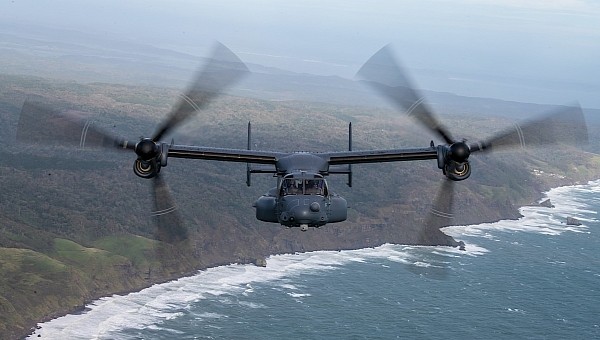38 feet (11.5 meters). That is the rotor diameter for the hardware that gets and keeps the CV-22 Osprey airborne. On a screen, those numbers may not seem like much. So here’s one of these tiltrotors trying to put things into perspective, courtesy of a recent U.S. Air Force (USAF) photo release.
The Osprey is one of those weird helicopter types. It came to be in the late 1980s, but only got to fly its first mission in 2007. Its maker, Bell Boeing, gifted it with capabilities not often seen in other aerial machines: it can take off vertically, like a helicopter, but then moves through the air like an airplane.
That’s possible thanks to those tilting nacelles, which can pivot forward by 90 degrees in as little as 12 seconds. Becoming a sort of airplane, with the propellers oriented vertically, the Osprey is a more fuel-efficient but also faster machine.
As the only one of its kind out there (a civilian tiltrotor called AW609 is currently in the works over at Leonardo), the Osprey is quite a sight every time it comes into the spotlight. Especially when we get a clear view of those massive blades.
The pic we have here, a perfect fit for our Photo of the Day coverage, was snapped by a staff sergeant back in October, at the time when this Osprey, deployed with the 21st Special Operations Squadron, was conducting a mission as part of exercise Resolute Dragon 22.
The drill, which is meant for the U.S. Marine Corps (USMC, the main user of the Osprey) and the Japanese Self-Defense Forces, took place over the Kamifurano Maneuver Area in Hokkaido, and it called for this particular machine to fly a support mission.
In doing so, the Osprey exposed itself to the Nikon camera of the staff sergeant in all its glory, with the two massive propellers spinning fast and menacingly to each side of the cockpit, and looking like the only weapons the tiltrotor would need to engage potential enemies.
That’s possible thanks to those tilting nacelles, which can pivot forward by 90 degrees in as little as 12 seconds. Becoming a sort of airplane, with the propellers oriented vertically, the Osprey is a more fuel-efficient but also faster machine.
As the only one of its kind out there (a civilian tiltrotor called AW609 is currently in the works over at Leonardo), the Osprey is quite a sight every time it comes into the spotlight. Especially when we get a clear view of those massive blades.
The pic we have here, a perfect fit for our Photo of the Day coverage, was snapped by a staff sergeant back in October, at the time when this Osprey, deployed with the 21st Special Operations Squadron, was conducting a mission as part of exercise Resolute Dragon 22.
The drill, which is meant for the U.S. Marine Corps (USMC, the main user of the Osprey) and the Japanese Self-Defense Forces, took place over the Kamifurano Maneuver Area in Hokkaido, and it called for this particular machine to fly a support mission.
In doing so, the Osprey exposed itself to the Nikon camera of the staff sergeant in all its glory, with the two massive propellers spinning fast and menacingly to each side of the cockpit, and looking like the only weapons the tiltrotor would need to engage potential enemies.













